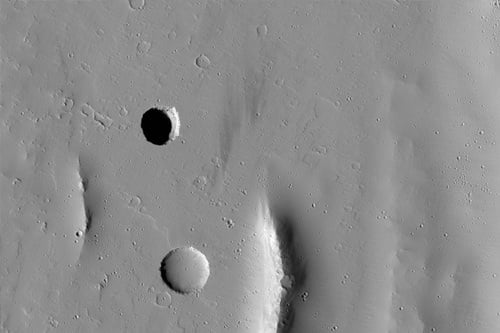[/caption]
Dark pits on Mars are fascinating – probably because they provide mysteries and possibilities. Could anything be inside? Or could this be a place where humans could set up a base since it would provide shelter from Mars' harsh environment? Some of the pits found earlier have been speculated to be entrances into caves, but more likely this is a collapse pit. Pits like this form by collapse into underground voids, such as those left by propagating magma-filled dikes. The pit in this image has very steep walls, and so only a narrow arc is illuminated by sunlight. The rest of the pit is in dark shadow. However, the HiRISE teams created a stretched version of the image, which shows details of the pit floor, due to a small amount of scattered sunlight. Anything interesting inside?
[caption id="attachment_27501" align="aligncenter" width="580" caption="The bottom is the pit is visible in this stretched image due to scattered light. Credit: NASA/JPL/ U of AZ"]
[/caption] No, not really; at least with the detail we can see here. The inside of the pit looks much the the surrounding region of Mars, but it could offer a possible habitat for future Mars explorers, even though the pit is quite deep, probably 150 meters (490 feet) deep. This pit is located in Tractus Fossae, a region of large ridges and troughs created by tectonic activity. Sometimes collapse pits may have overhanging walls, although in this case the walls can be seen and appear nearly vertical.
This pit is essentially a vertical shaft cut through the lava flows on the flank of the volcano. Such pits form on similar volcanoes in Hawaii and are called 'pit craters.' They generally do not connect to long open caverns but are the result of deep underground collapse.
The fossae, or troughs, occur on the Tharsis volcanic rise, a giant region of enhanced volcanic activity that includes the three large volcanoes Ascraeus Mons, Pavonis Mons and Arsia Mons.
Source:
HiRISE
 Universe Today
Universe Today
